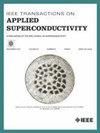城市轨道交通v型PMG上的HTS固定磁悬浮系统动力学研究
IF 1.8
3区 物理与天体物理
Q3 ENGINEERING, ELECTRICAL & ELECTRONIC
引用次数: 0
摘要
高温超导(HTS)钉钉式磁悬浮是一种新兴的交通运输技术,由于其固有的被动自稳定、低能量损耗和无噪音运行而引起了人们的极大兴趣。基于HTS固定的基本原则,设计和开发了一个创新的城市交通系统。与传统的高温超导磁悬浮运输系统依赖于扁平结构的永磁导轨(PMG)相比,该系统采用了创新的v形PMG结构。这种结构的改进大大增加了垂直悬浮力和横向导引力,从而提高了操作性能和动态稳定性。系统地分析了该系统的技术进步和动态特性,以评估城市交通应用中的车辆动力学。初步的模拟结果证明了技术可行性,并完全符合既定的目标速度操作标准。本研究旨在为HTS钉住式磁悬浮运输系统的动态性能评价和工程设计奠定理论基础。本文章由计算机程序翻译,如有差异,请以英文原文为准。
Dynamics of an HTS Pinning Maglev System on a Stability-Enhanced V-Shaped PMG for Urban Transit
High-temperature superconducting (HTS) pinning magnetic levitation (maglev) represents an emerging transportation technology that has attracted significant research interest owing to its intrinsic passive self-stabilization, low energy dissipation, and noise-free operation. Building upon the fundamental principles of HTS pinning, an innovative urban transit system has been designed and developed. In contrast to conventional HTS maglev transportation systems relying on flat-configured permanent-magnet guideways (PMGs), the proposed system incorporates an innovative V-shaped PMG configuration. This structural modification substantially amplifies both vertical levitation and lateral guidance forces, thereby enhancing operational performance and dynamic stability. The system’s technological advancements and dynamic characteristics have been systematically analyzed to assess vehicle dynamics for urban transit applications. Initial simulation results demonstrate technical viability and full compliance with established operational standards at target velocities. This research aims to establish a theoretical foundation for dynamic performance evaluation and engineering design of HTS pinning maglev transportation systems.
求助全文
通过发布文献求助,成功后即可免费获取论文全文。
去求助
来源期刊

IEEE Transactions on Applied Superconductivity
工程技术-工程:电子与电气
CiteScore
3.50
自引率
33.30%
发文量
650
审稿时长
2.3 months
期刊介绍:
IEEE Transactions on Applied Superconductivity (TAS) contains articles on the applications of superconductivity and other relevant technology. Electronic applications include analog and digital circuits employing thin films and active devices such as Josephson junctions. Large scale applications include magnets for power applications such as motors and generators, for magnetic resonance, for accelerators, and cable applications such as power transmission.
 求助内容:
求助内容: 应助结果提醒方式:
应助结果提醒方式:


